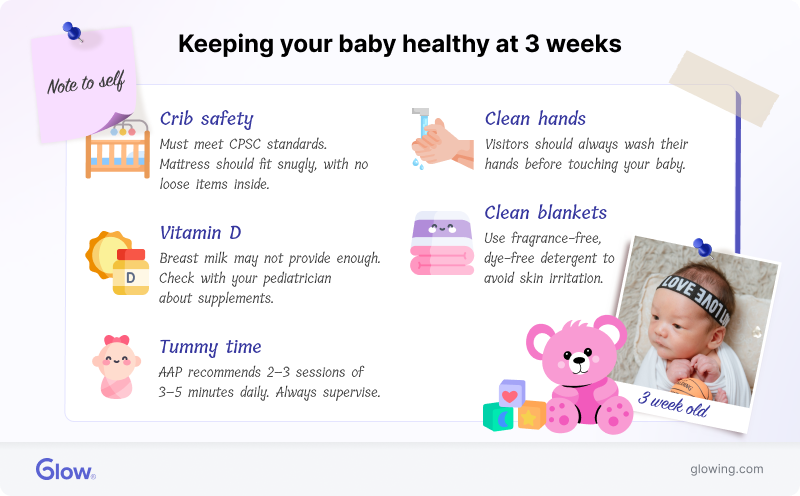Baby Month by Month
3-Week-Old Baby
Your baby has probably regained the weight he lost after birth by now.

- What are your baby’s developmental milestones at 3 weeks?
- What to know about feeding your 3-week-old
- What to know about your 3-week-old’s sleep patterns
- What are common health concerns at 3 weeks?
- How to keep your baby safe and healthy
- When to contact your pediatrician
- How to look after yourself in week 3
- Final thoughts
This week brings new developments and growing pains for both you and your baby. Let’s look at what milestones you can expect, what health issues to watch out for, and a few tips to help you roll with the week 3 wave.
What are your baby’s developmental milestones at 3 weeks?
At this point, your baby should have regained his birth weight, and he’ll continue to gain about 4 to 7 ounces per week.
Don’t worry about how your baby’s weight compares to other infants—every child is unique. 1 Your pediatrician will track his growth at your well-baby appointments and let you know if any adjustments need to be made to his feeding schedule.
You can also track his growth by recording his measurements in your diary or in a baby tracker app. The best baby trackers also compare your baby’s data to the standard World Health Organization (WHO) and Centers for Disease Control and Prevention (CDC) growth charts.
Other milestones your baby is hitting include:
Increased alertness and interaction
Your baby is now more aware of his surroundings, although he can still only clearly see objects about 8 to 10 inches away. The higher the contrast, the better he can see it, so black-and-white patterns will grab his attention best for now. 2
Strength and coordination
Though he can’t lift his head up on his own yet, your baby’s tummy time (placing your baby on his tummy for gradually increasing intervals) will strengthen his neck, abdominal, and back muscles. These muscles will help him once he starts crawling. Tummy time can also prevent flat spots on his head.
For now, watch him move his head back and forth, wiggle his limbs, and grasp your finger. You can encourage his burgeoning coordination by interacting and playing with him. 3 4
Communication
While your baby’s cries may sometimes seem random, they’re his way of communicating with you. He might be more vocal or prone to fussy periods than he was in previous weeks, which could either be due to gas or colic.
As you respond to his cues, you’ll begin to understand what he wants. Don’t be discouraged if you’re not fluent in “baby talk” yet; like any language, it takes time to learn.
What to know about feeding your 3-week-old
Your 3-week-old will likely eat every 2–4 hours (3–4 for formula-fed babies), consuming about 2–3 ounces of breastmilk or formula per feeding. All that adds up to around 24–30 ounces daily. 5 6 7
Changes in your baby’s feeding habits
Sometimes, your baby’s feeding cycle will suddenly shorten, meaning he’ll cry for food more often. Known as cluster feeding, this can be a sign that he’s going through a growth spurt or storing up energy for a longer sleep cycle.
Similarly, if your baby seems hungrier in the evening, that might mean he’ll sleep for longer.
In either case, don’t hold back. Following your baby’s hunger and fullness cues (called responsive feeding) ensures he gets enough to eat. You can establish feeding schedules later, but for now, feed your baby whenever he wants to be fed.
Dealing with spit-up
Another common habit at this age is spitting up milk after meals. This normally isn’t anything to worry about—if your baby only spits up a few spoonfuls of milk, he isn’t losing much. However, spitting up a lot of milk or projectile vomiting are signs that he needs to see a doctor immediately. 8
Dealing with gas
Babies typically experience a lot of gas at this age. Your baby may gulp air when feeding, react to something in your breastfeeding diet (which affects your milk’s composition), or have trouble digesting his food—that’s a new process for his body, after all.
If you’re breastfeeding, make sure he gets a good latch to reduce air swallowing, and if you’re bottle-feeding, consider switching to a slower-flow nipple, and make sure to keep the bottle tilted upwards so he doesn’t swallow air. 9
You can also experiment with different bottles to see what works for your baby. The best baby bottles have anti-colic designs that are popular among moms with gassy babies, as they reduce the amount of air babies swallow while feeding.
Other tips to help your baby avoid or pass gas: 10
- Burp your baby during and after feeding
- Feed him in an upright position
- Have more tummy time
- Gently rub your baby’s belly
How many diapers should your baby go through per day?
At week 3, your baby should produce at least six wet diapers a day. The color and consistency of his bowel movements will depend on whether he’s breastfed or formula-fed. 11 Breastfed babies tend to have looser, seedier stools, while formula-fed babies may have firmer poops. 12
If your baby isn’t meeting his expected number of dirty diapers in 24 hours or passes hard, rock-like stools, he’s probably constipated. You can try giving him a belly massage or pumping his legs as if he’s riding a bike to help things move along. 13
If that doesn’t help or your baby goes 4 days without a bowel movement, contact your doctor.
Tips for breastfeeding and formula feeding
If you’re breastfeeding, let your baby fully finish one breast before offering the other. This allows him to receive more of the hindmilk, which is richer in fat and has more calories than the foremilk (which he’ll drink first).
If you formula feed instead, pay attention to how your baby takes the bottle. If he gulps down the milk too quickly or gets fussy, you may need to switch to a different nipple or baby bottle.
You can often safely store formula if your baby doesn’t finish it. Unused formula stays good for up to 24 hours in the refrigerator, as long as you store it properly (e.g., tightly sealed in a container).
Always consult your pediatrician if you have any concerns about feeding your baby. You can also call on a lactation consultant for support if you’re having any issues breastfeeding. 14
What to know about your 3-week-old’s sleep patterns
While your baby doesn’t yet know the difference between day and night, you can do a few things to help develop his circadian rhythm (the internal clock that allows him to distinguish between them). 15
During the day, keep the lights on and interact with him to keep things lively. At night, dim the lights and keep his environment calm and quiet.
When you put your baby down for naps or nighttime sleep, place him in his crib or bassinet when he’s drowsy but not fully asleep. This gets him used to falling asleep alone. You can also play white noise to help block out sounds from other rooms and simulate the sounds of the womb.
How much sleep does a 3-week-old need?
At week 3, your little one needs between 16 and 18 hours of sleep in a 24-hour period (so no, your newborn is not sleeping too much, in case you were worried). 16 This downtime hopefully will give you a chance to sneak some naps in there yourself.
Don’t expect your baby to sleep through the night until he is around three months old. Right now, he’ll only sleep for 2 to 4 hours at a time, with feedings and diaper changes in between, during those wake windows when he’s up. 17
It’s important to remember that frequent night wakings are normal and necessary at this age. As an adult, you can store energy for a lot longer, but your baby is growing fast and needs to be fed often.
Dealing with overtiredness
Sometimes, a baby who seems like he’s fighting sleep is actually overtired. In other words, as odd as it might sound, he’s just too tired to fall asleep.
You can avoid overtiredness by putting your baby down for bed sooner and comforting him to help him fall asleep faster. You can’t spoil a newborn, so don’t hesitate to cuddle him as much as he needs.
What are common health concerns at 3 weeks?
This week, your baby’s development may also come with some health concerns. Be on the lookout for the three C’s: colic, cradle cap, and congestion.
Colic
Unfortunately, 3 weeks often marks the arrival of a very unwelcome condition: the dreaded colic. This is characterized by excessive, inconsolable crying for more than three hours a day, for at least three days a week. 18
Though colic doesn’t have a known cause or cure, overstimulation or discomfort from gas are possible culprits. Pediatricians recommend “5 S’s” method for soothing a colicky baby:
- Swaddling: Research how to swaddle your baby correctly. Keep the blanket loose around his hips to avoid the loosening or dislocation of the hip joint (known as dysplasia).
- Side/stomach position: Hold your baby on his side or stomach.
- Shushing: Speak softly to him, make quiet shushing sounds, or play relaxing music to calm him down.
- Swinging: Slowly rock him back and forth in your arms. You can also hold him to your chest, offering skin-to-skin contact.
- Sucking: Offer him a pacifier or bottle.
You can also try taking your baby for a walk in his baby stroller or going for a quick car ride.
If you can’t seem to calm him down, contact your pediatrician to see if your baby has a medical problem. In the meantime, try to stay sane. It’s okay to set him down in his bassinet (as long as you place him in a safe position) and take a break for 5 minutes if the crying gets to be too much to handle.
Cradle cap
Have you noticed yellowish-white patches of scales on your baby’s scalp? If so, the chances are good he has cradle cap. Cradle cap is caused by a yeast infection, but it isn’t dangerous and typically goes away in the first year. However, your baby may scratch the area, which can cause it to bleed or get infected. 19
You can treat cradle cap by gently massaging your baby’s scalp to dislodge the scales, shampooing his hair with a baby-safe shampoo, and brushing his hair several times a day with a baby brush and a little bit of coconut oil. Just be sure to wash any brushes you use on your baby’s hair with soap and water each day to keep it clean.
If cradle cap doesn’t improve or causes your baby visible discomfort, talk to your doctor.
Congestion
Congestion is common at this age, and it isn’t necessarily a sign of an actual illness. You can clear up congestion in a couple of ways:
- Adding a humidifier to your baby’s room to add moisture to the air
- Using saline nose drops or spray to dislodge the mucus
- Sucking the mucus out with a bulb syringe
While congestion doesn’t usually mean your baby is sick, you should always keep an eye on his temperature. If he has a fever of 100.4°F or higher or has any trouble breathing (including trouble breathing through his nose while feeding), contact your pediatrician right away. 20

How to keep your baby safe and healthy
During your baby’s first month, his health is particularly delicate. Here are some tips on how to take care of him:
- Crib safety: Check that the crib you choose conforms to the standards set by the Consumer Product Safety Commission (CPSC). The mattress should fit snugly, and there shouldn’t be any loose blankets, pillows, bumpers, or toys inside. 21
- Vitamin D: Breast milk is loaded with a lot of nutrients your baby needs, but it might not provide enough vitamin D. Even if you supplement your breast milk with formula, he may need vitamin D drops. Talk to your pediatrician about whether your baby is getting enough vitamin D. 22
- Tummy time: The American Academy of Pediatrics (AAP) recommends 2–3 tummy time sessions for about 3-5 minutes each day. Always pay attention to your baby and his environment; he can’t move very easily on his own yet, so it’s important to watch him. 23
- Clean hands: Everybody wants to coo over your baby, but unless they’re cooing from a distance, make sure they wash their hands before touching him. Your baby doesn’t have a strong immune system at this age, and hand washing can prevent bacteria and viruses from passing to him.
- Clean blankets: Between diaper changes gone wrong and spit-ups after feeding, your baby makes a lot of messes. When cleaning his blankets and clothes, use a fragrance-free, dye-free, hypoallergenic laundry detergent to avoid irritating his skin.
You may also want to buy a pacifier to soothe your baby, especially if he’s colicky. However, if you do, don’t over-rely on it. Use it in short spurs, and don’t let it replace feeds.
Also, be careful about using a pacifier once your baby gets older. There’s evidence that they may cause dental issues, although you don’t need to worry about this for a long time (until he’s about 18 months old).
Circumcision care
If your baby is uncircumcised, his foreskin may not be able to retract for years after birth. If so, that’s okay. Simply clean the outside of your baby’s penis for now; the foreskin will retract in its own time. 24
If you had your baby circumcised, his penis will probably take 7–10 days to heal. Once healed, you can clean it the same as the rest of his body. 25
Caring for your baby’s moles
If your baby has a mole, don’t panic. Many babies are born with moles or develop them later on in childhood, and they’re usually harmless.
However, you should still keep an eye on his mole, and let your doctor know if it:
- Is asymmetrical
- Is unusually large (about the size of a pencil eraser or more)
- Has an uneven mix of colors or shades
- Has changed in appearance
Baby acne
Baby acne, also known as neonatal acne, tends to appear in a baby’s first 6 weeks of life. You’ll probably notice it around your baby’s face, but it can also affect his neck, back, and chest, too.
It should resolve on its own by the time your baby’s 4 months old to 6 months old. However, don’t hesitate to reach out to your doctor if it seems to cause your baby any discomfort or pain.
When to contact your pediatrician
You’ll have a well-baby visit coming up at the one-month mark, but don’t hesitate to contact your pediatrician if you have any concerns about your baby’s health, feeding, or development before then.
As mentioned, any fever of 100.4°F or higher, signs of dehydration (less wet diapers than expected), or sudden changes in your baby’s behavior are all reasons to call the doctor.
How to look after yourself in week 3
As gratifying as it can be to hold your baby in your arms, week 3 can also be stressful. To avoid getting overwhelmed, keep these tips in mind:
- Take breaks: Many parents suffer from sleep deprivation, especially when colic rears its ugly head. Make time for yourself, even if it’s just a few minutes, and take naps when you can. If you’re feeling frustrated, put your baby in a safe place and take a few deep breaths. Looking after your own health helps you care for your baby.
- Make a schedule: If you have a co-parent, create a schedule that divides up childcare. This way, both of you will get enough rest and have time to bond with your baby. Even if you’re going it alone, creating a consistent routine for yourself and your baby will help you find your rhythm.
- Ask for help: You don’t have to deal with the stresses of parenting alone. When you feel stressed, ask for help from your partner, family, or friends. If that isn’t a practical option, you can check out online parent groups or local support networks.
After having your baby, you may also struggle with postpartum depression or postpartum rage. If you feel overwhelming sadness or, on the flip side, extreme irritability (or any unmanageable changes in your mood, really), reach out to your doctor for support.
Final thoughts
As stressful as these first few weeks can be, be patient with yourself and your baby. He’ll only be this age once, so make the most of it. Before you know it, these early growing pains, colic, and insatiable appetite will be a distant memory, and your baby will start taking on the world, one step at a time.
Article Sources
- Arizona Department of Health Services. "Normal Growth Patterns" Retrieved July 16, 2025.
- Michigan State University. "Infant vision development: Helping babies see their bright futures!" Retrieved July 16, 2025.
- Safe to Sleep. "Tummy Time for a Healthy Baby" Retrieved July 16, 2025.
- MedlinePlus. "Infant - newborn development" Retrieved July 16, 2025.
- U.S. Centers for Disease Control and Prevention. "How Much and How Often to Breastfeed" Retrieved July 16, 2025.
- U.S. Centers for Disease Control and Prevention. "How Much and How Often to Feed Infant Formula" Retrieved July 16, 2025.
- Montana Department of Public Health and Human Services (DPHHS). "Infant Feeding Guide" Retrieved July 16, 2025.
- University of Rochester Medical Center. "Gastrointestinal Problems" Retrieved July 16, 2025.
- Penn Medicine. "News and views" Retrieved July 16, 2025.
- The Children's Hospital of Philadelphia. "How to Help a Newborn with Gas" Retrieved July 16, 2025.
- Kaiser Permanente. "Baby’s Diapers: What’s Normal, What’s Not" Retrieved July 16, 2025.
- UnityPoint Health. "Breastfeeding Poop vs. Formula Poop. What's the Difference?" Retrieved July 16, 2025.
- South Dakota WIC. "Constipation 0-12 months" Retrieved July 16, 2025.
- NYC Health + Hospitals. "Ask Our Expert, Women’s Health" Retrieved July 16, 2025.
- Sleep Foundation. "Circadian Rhythm" Retrieved July 16, 2025.
- The Michigan Department of Health and Human Services (MDHHS). "Baby Sleeping and Eating: What is Normal?" Retrieved July 16, 2025.
- Washington State Department of Health. "Healthy Sleep for Babies" Retrieved July 16, 2025.
- Oregon Health Authority. "Common Infant Problems - Colic" Retrieved July 16, 2025.
- MedlinePlus. "Cradle cap" Retrieved July 16, 2025.
- University of Rochester Medical Center. "Fever in a Newborn Baby" Retrieved July 16, 2025.
- U.S. Consumer Product Safety Commission. "Safe Sleep – Cribs and Infant Products" Retrieved July 16, 2025.
- U.S. Centers for Disease Control and Prevention. "How Much and How Often to Breastfeed" Retrieved July 16, 2025.
- Pediatric Patient Education (2022). "Back to Sleep, Tummy to Play" Retrieved July 16, 2025.
- The Children's Hospital of Philadelphia. "Care of the Uncircumcised Penis" Retrieved July 16, 2025.
- University of Rochester Medical Center. "Circumcision for Children" Retrieved July 16, 2025.







